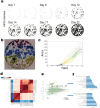A Machine Learning Assisted, Label-free, Non-invasive Approach for Somatic Reprogramming in Induced Pluripotent Stem Cell Colony Formation Detection and Prediction
- PMID: 29044152
- PMCID: PMC5647349
- DOI: 10.1038/s41598-017-13680-x
A Machine Learning Assisted, Label-free, Non-invasive Approach for Somatic Reprogramming in Induced Pluripotent Stem Cell Colony Formation Detection and Prediction
Abstract
During cellular reprogramming, the mesenchymal-to-epithelial transition is accompanied by changes in morphology, which occur prior to iPSC colony formation. The current approach for detecting morphological changes associated with reprogramming purely relies on human experiences, which involve intensive amounts of upfront training, human error with limited quality control and batch-to-batch variations. Here, we report a time-lapse-based bright-field imaging analysis system that allows us to implement a label-free, non-invasive approach to measure morphological dynamics. To automatically analyse and determine iPSC colony formation, a machine learning-based classification, segmentation, and statistical modelling system was developed to guide colony selection. The system can detect and monitor the earliest cellular texture changes after the induction of reprogramming in human somatic cells on day 7 from the 20-24 day process. Moreover, after determining the reprogramming process and iPSC colony formation quantitatively, a mathematical model was developed to statistically predict the best iPSC selection phase independent of any other resources. All the computational detection and prediction experiments were evaluated using a validation dataset, and biological verification was performed. These algorithm-detected colonies show no significant differences (Pearson Coefficient) in terms of their biological features compared to the manually processed colonies using standard molecular approaches.
Conflict of interest statement
The authors declare that they have no competing interests.
Figures




Similar articles
-
Enhancing Induced Pluripotent Stem Cell Generation by MicroRNA.Methods Mol Biol. 2016;1357:71-84. doi: 10.1007/7651_2015_201. Methods Mol Biol. 2016. PMID: 25687299
-
Induced Pluripotent Stem Cells: Generation, Characterization, and Differentiation--Methods and Protocols.Methods Mol Biol. 2016;1357:395-401. doi: 10.1007/7651_2014_148. Methods Mol Biol. 2016. PMID: 25403469
-
Stiffness of Hydrogels Regulates Cellular Reprogramming Efficiency Through Mesenchymal-to-Epithelial Transition and Stemness Markers.Macromol Biosci. 2016 Feb;16(2):199-206. doi: 10.1002/mabi.201500273. Epub 2015 Oct 6. Macromol Biosci. 2016. PMID: 26439948
-
A review of induced pluripotent stem cell, direct conversion by trans-differentiation, direct reprogramming and oligodendrocyte differentiation.Regen Med. 2016 Mar;11(2):181-91. doi: 10.2217/rme.16.5. Epub 2016 Feb 9. Regen Med. 2016. PMID: 26857809 Review.
-
Laser-assisted generation of human induced pluripotent stem cells.Curr Protoc Stem Cell Biol. 2014 Nov 3;31:4A.7.1-15. doi: 10.1002/9780470151808.sc04a07s31. Curr Protoc Stem Cell Biol. 2014. PMID: 25366899 Review.
Cited by
-
AI-Driven Quality Monitoring and Control in Stem Cell Cultures: A Comprehensive Review.Biotechnol J. 2025 Aug;20(8):e70100. doi: 10.1002/biot.70100. Biotechnol J. 2025. PMID: 40785233 Free PMC article. Review.
-
Challenges in Physiological Phenotyping of hiPSC-Derived Neurons: From 2D Cultures to 3D Brain Organoids.Front Cell Dev Biol. 2020 Aug 26;8:797. doi: 10.3389/fcell.2020.00797. eCollection 2020. Front Cell Dev Biol. 2020. PMID: 32984317 Free PMC article.
-
High-throughput "read-on-ski" automated imaging and label-free detection system for toxicity screening of compounds using personalised human kidney organoids.J Zhejiang Univ Sci B. 2022 Jul 15;23(7):564-577. doi: 10.1631/jzus.B2100701. J Zhejiang Univ Sci B. 2022. PMID: 35794686 Free PMC article.
-
The Dynamics of Metabolic Characterization in iPSC-Derived Kidney Organoid Differentiation via a Comparative Omics Approach.Front Genet. 2021 Feb 10;12:632810. doi: 10.3389/fgene.2021.632810. eCollection 2021. Front Genet. 2021. PMID: 33643392 Free PMC article.
-
Understanding blood development and leukemia using sequencing-based technologies and human cell systems.Front Mol Biosci. 2023 Oct 10;10:1266697. doi: 10.3389/fmolb.2023.1266697. eCollection 2023. Front Mol Biosci. 2023. PMID: 37886034 Free PMC article. Review.
References
Publication types
MeSH terms
LinkOut - more resources
Full Text Sources
Other Literature Sources

